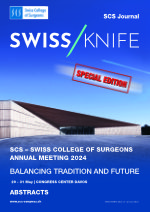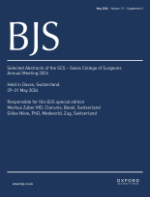Visual Poster SCS – Swiss College of Surgeons Annual Meeting 2024
The Visual Abstracts are displayed near the industry exhibition, located on the «Parkgeschoss».
All authors are kindly asked to put the Visual Abstracts on display on Thursday morning, May 30th
and be present during the poster walk on Thursday, May 30th, from 14h15 to 16h30, to answer questions from interested colleagues.
Find the special editions of swiss knife and the BJS, which include the best abstracts presented at the SCS – Swiss College of Surgeons Annual Meeting 2024!
|
08:00 – 17:00
|
Visual Abstracts |
|
|
P1
Splenic Rupture, a new Concern Post-Colonoscopy? A Case Report.
|
||
|
P2
An Unusual Course of a Duodenal Peptic Ulcer
|
||
|
P3
Appendiceal Diverticulitis Mimicking Acute Appendicitis
|
||
|
P4
Acute Abdominal Challenges: Surgical Resolution of Adult Congenital Intestinal Malrotation
|
||
|
P6
Inside out: A Tricky Case of Appendicitis
|
||
|
P7
Spontaneous Perforation of Urinary Bladder on Hereditary Haemorrhagic Telangiectasia (Osler-Weber-Rendu syndrome): a case report.
|
||
|
P8
Strangulated small bowel volvulus within a right paraduodenal hernia: case report of a rare cause small bowel obstruction and review of the literature.
|
||
|
P9
Is conservative management safe for of mesenteric venous ischemia? : two cases report
|
||
|
P10
Lipiodol® lymphangiography as a treatment for post-operative chylous ascites: a retrospective single-centre study
|
||
|
P11
Strangulated small bowel volvulus within a right paraduodenal hernia: case report of a rare cause small bowel obstruction and review of the literature.
|
||
|
P12
Trauma-related still asymptomatic sigmoid volvulus
|
||
|
P13
Ceacal Volvulus in a Tetraplegic Patient
|
||
|
P14
Laparoscopic treatment of type II gastro-gastric fistula post Roux-en-Y gastric bypass: a case report video
|
||
|
P16
Impact of Herpes-associated pneumonia on patient’s outcome after cardiac surgery
|
||
|
P17
Fish Skin Grafts for Paediatric Degloving Injuries
|
||
|
P18
Exploring the Anatomy of the Piriformis Muscle: A Comprehensive Study Using MRI, Ultrasound and Dissection
|
||
|
P19
Molecular Characterization and Validation of Live Cell Biobank for Pleural Mesothelioma
|
||
|
P20
Necroptosis Induced By Prolonged Cold Static Preservation Involves The Cgas/Sting Pathway And Calcium Handling In Cellular And Rat Models Of Cold Lung Preservation
|
||
|
P21
Transient heat stress protects from endothelial injury during prolonged ex-vivo perfusion of warm ischemic rat lungs
|
||
|
P22
Consequences of COVID-19 on the Epidemiology of Child Burns in Lausanne: A Retrospective Observational Study
|
||
|
P23
Febrile Intestinal Obstruction in a Child Caused by a Meckel’s Diverticulitis: A Case Report
|
||
|
P24
A case of untreated papillary thyroid cancer for 37 years
|
||
|
P25
Adrenocortical Oncocytic Neoplasm: a case report
|
||
|
P26
A bifid gallbladder? A challenging laparoscopic cholecystectomy
|
||
|
P27
Atypical Metachronous Metastases From Pancreatic Adenocarcinoma
|
||
|
P28
Splenic torsion in a patient with situs inversus totalis and polysplenia. Challenging diagnosis and treatment of a rare case – Case report and review of the literature
|
||
|
P29
Acinar cystic transformation (ACT) of the pancreas: focus on radiological imaging and diagnosis. Presentation of two cases and review of literature.
|
||
|
P30
Giant sclerosing hepatic hemangioma presenting as Bornman-Terblanche-Blumgart syndrome (BTBS): a case report
|
||
|
P31
Heterotopic Pancreas in the Stomach Wall
|
||
|
P32
Multidisciplinary tratment of a complex type 1 Mirizzi Syndrome
|
||
|
P33
Large Morgagni Hernia in an Adult Patient With Trisomy 21
|
||
|
P34
A rare Case of a Small Inferior Lumbar Hernia initially misdiagnosed as Subcutaneous Lipoma, treated with a Mesh Plug Hernioplasty
|
||
|
P35
Treatment of a Huge Inguinoscrotal Hernia with “Loss of Domain”
|
||
|
P36
Appendicitis Within an Amyand Hernia: Case Report of a Rare Surgical Entity
|
||
|
P37
Cyst of the canal of Nuck in an adult female patient: A case report.
|
||
|
P38
Perforated Femoral Richter’s Hernia: A Case Report
|
||
|
P39
Laparoscopic management of jejunal intussusception caused by jejunal lipoma: a rare case in adults
|
||
|
P40
Bowel fistula to the thigh after colon and bowel perforation following a minor pelvic trauma
|
||
|
P41
Combined Stapled Mucopexy & Milligan-Morgan’s technique in Circumferential 4th degree Haemorrhoids: Prospective Observational Cohort Study
|
||
|
P42
Spontaneous Resolution of Gallstone Ileus in the Sigmoid Colon With a Post-Diverticulitis Substenosis : A Case Report
|
||
|
P43
Surgical Management of Acute Small Bowel Occlusion due to a Suspected Neuroendocrine Tumor.
|
||
|
P44
Comparative Efficacy of Laser Hemorrhoidectomy Versus Traditional Milligan-Morgan and Recto Anal Repair Techniques in Treating Stages I-III Hemorrhoids: A 3-Year Progressive Study
|
||
|
P45
Hepato-Colic Fistula in a Patient with Crohn’s Disease: A Case Report
|
||
|
P46
Preoperatively Elevated C-reactive Protein Level as an Independent Risk for Postoperative Complications After Pelvic Exenteration: A Single Center Retrospective Study
|
||
|
P48
Supraclavicular first rib resection for thoracic outlet syndrome (TOS): patient rated outcome measures (PROMs) and length of posterior rib remnant
|
||
|
P49
Closure of a Clagett Window using a Pedicled Omental Flap: Technique Description and Perfusion Control using Indocyanine Green Fluorescence
|
||
|
P50
Giant anterior mediastinal mass - a case report
|
||
|
P51
Perioperative Outcomes Following Lung Resection in Metastatic Non-Small Cell Lung Cancer: Results of a Large Multicenter Database
|
||
|
P52
Unmasking the Hidden Culprit: Post-Operative SGLT2 Inhibitor-Induced Euglycemic Diabetic Ketoacidosis
|
||
|
P53
Is it Safe to Remove Chest Drains Without a Priori Chest X-ray Following Anatomical Lung Resections in Patients With Non-Small Cell Lung Cancer
|
||
|
P54
Influential Factors in Intra- and Postoperative Outcomes Following Anatomical Lung Resections: A Comparison of VATS and RATS Procedures
|
||
|
P55
Rare Discovery: Partial Pericardial Agenesis Unveiled During Thymectomy - a Case Report
|
||
|
P56
Indirect recognition HLA score as a predictor of CLAD in Lung Transplant.
|
||
|
P58
Catamenial pneumothorax – a rare entity which should be kept in mind!
|
||
|
P59
Novel MicroRNAs are Associated With Presence of Pleural Mesothelioma and Response to Chemotherapy
|
||
|
P60
Opioid-free thoracic surgery after intercostal cryoanalgesia: An initial experience and long-term outcome.
|
||
|
P62
Low Ki-67 Positive Index is a Prognostic Factor for Better Survival Outcomes of Patients Treated with Intracavitary Cisplatin-Fibrin
|
||
|
P63
Case report: «Salvage surgery for recurrent main pulmonary artery sarcoma »
|
||
|
P64
Robotic-Assisted Resection of a Large Intrathoracic Sympathetic Chain Schwannoma
|
||
|
P65
Spread through air spaces (STAS): a growing clinical challenge in resectable early-stage non-small cell lung cancer
|
||
|
P66
Is the expectance of a low dose CT scan associated with psychological distress in lung cancer screening?
|
||
|
P67
Impact of the establishment of a multidisciplinary national Chronic thromboembolic pulmonary hypertension (CTEPH) Board on a monocentric surgical endarterectomy program
|
||
|
P68
Understanding the contribution of different cell types in the development of chronic thromboembolic pulmonary hypertension (CTEPH)
|
||
|
P69
RATS Extended pneumonectomy for T4 (aortic adventitia) NSCLC after induction treatment following prophylactic Aortic Stent Implantation - a case report
|
||
|
P70
A Permanent Thoracic Window Model for Real-time Imaging of Non-Small Cell Lung Cancer in its Orthotopic Setting
|
||
|
P71
periOPTIME - The New Kid on the Block - A Refined Enhanced Recovery Program
|
||
|
P72
Case Report : Azygos Vein Aneurysm, a Chameleon Lesion Difficult to Clarify Without Invasive Diagnostic Tools
|
||
|
P73
Doege potter syndrome : a giant solitary fibrous pleural tumor causing severe hypoglycemia
|
||
|
P74
Intraoperative 3D-fluoroscopy increases accuracy of syndesmotic reduction in ankle fractures with syndesmotic instability
|
||
|
P76
Indications for MusculoSkeletal Temporary Surgery (MUST) in physiologically compensated patients
|
||
|
P77
Long bone shaft, pelvis and acetabulum fracture fixation in polytrauma: priorities in context of traumatic injuries of the head, chest, abdomen, spine, spinal cord and vasculature
|
||
|
P78
Closed reduction followed by percutaneous fixation of acute femoral neck fractures in young adults is safe and feasible: a retrospective cohort study
|
||
|
P79
Locking Pegs Versus Locking Screws in Volar Plating of Distal Radius Fractures
|
||
|
P80
Routine 6-weeks outpatient visit in patients treated surgically for upper extremity fractures: Is it truly necessary?
|
||
|
P81
The Complex Setting of Seizure-Induced Humeral Head Fractures
|
||
|
P82
Case Report of a Double Plate Two Level Open Reduction Internal Fixation (ORIF) of a Trimalleolar Fracture and Insufficient Tibial Plateau Fracture With Immediately Protected Full Weight Bearing (IWB) by a Noncompliant Alcoholic
|
||
|
P83
Silent Compartment Syndrome
|
||
|
P84
Additional femoral neck screw in gamma nail osteosynthesis for combined femoral neck fractures and pertrochanteric fractures
|
||
|
P85
Complex Penetrating Transmediastinal Flagpole Injury
|
||
|
P86
Recurrence of perforated duodenal ulcer after Roux-en-Y gastric bypass: a case report
|
||
|
P87
A Rare Complication of an Unusual Procedure: Phytobezoar on LINX
|
||
|
P88
Another Case of Common Cholestasis?
|
||
|
P89
Giant unknown abdominal tumor in emergency department
|
||
|
P90
Quality of Life and Independent Factors Associated with Poor Digestive Function after Ivor Lewis Esophagectomy
|
||
|
P91
Endograft explantation and in-situ reconstruction with a self-made xenopericardial graft in EVAR infection
|
||
|
P92
Handmade pericardial covered stent as interposition graft in Nutcracker syndrome : A case report
|
||
|
P93
Emergency Endovascular Repair of Iatrogenic Subclavian Artery Perforation: A Case Report
|
||
|
P94
Mortality and Recurrence Rate of the Martorell Ulcer: Experience in a Secondary Center
|
||
|
P95
What Does an Abdominal Vascular Aneurysm, Spondylodiscitis, Psoas Abscess and Coxiella Burnetti Have in Common? A Case Report of a Patient with Chronic Q-Fever
|
||
|
P96
Topic Tacrolimus: an Important Tool to Diagnose and Treat Pyoderma Gangrenosum
|
||
|
P97
Complete thoracic endovascular aortic repair with insitu-fenestration under cerebral perfusion with ECMO – A case report
|
||
|
P98
Surgical Management of Refractory Venous Ulcers in a Patient With Extensive Dystrophic Subcutaneous Calcifications: a Case Report
|








